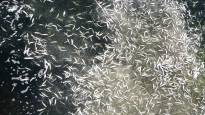Pohjanlahti herring received a yellow label, meaning it should be used with caution. Riianlahti herring remained green.
The environmental organization WWF has tightened its recommendation on the use of herring in the Baltic Sea. The reason is the decline of the most important herring stocks in the Baltic Sea.
WWF has updated its fish guide, which gives instructions on the responsible consumption of fish. The guide now outlines that herring caught from the Gulf of Bothnia should be used with care and herring trawled from the Baltic Sea’s main basin should be avoided completely.
WWF uses so-called traffic light markings in its fish guide. The marking of herring in Pohjanlahti has changed from green to yellow, and the marking of herring trawled from the main pool has changed from yellow to red. Among Baltic herrings, the herring caught from the Gulf of Riga is still marked in green.
The stocks of fish marked in green in the fish guide are viable and their catch does not cause environmental harm. According to WWF, the sustainability of the species marked in yellow can be associated with risks and uncertainties. Species marked in red are recommended to be avoided.
Some strains fell below the critical level
According to the latest stock estimates, the most important herring stocks in the Baltic Sea have fallen below target levels, which is an alarming sign of changes in the Baltic Sea’s ecosystem and food webs, WWF says in a press release.
According to the organization, the Pohjanlahti herring population has fallen below its target level for the first time. Herring stocks in the main Baltic Sea basin and the Gulf of Finland have declined below the critical level.
In August, the European Commission proposed suspending the targeted fishing of herring in the Baltic Sea for next year. According to the commission, the amount of herring in Pohjanlahti has fallen below the sustainable stock and without restrictions the amount would probably decrease even more.
WWF conservation expert Matti Ovaska says in the announcement that fishing is only one of the factors explaining the decline of herring. Still, a significant cut in trawl fishing in particular would be important, according to him.
– Due to climate change and eutrophication, the habitat of fish has changed, and the species at the top of the food chain react quickly. Herring is an example of a species that is strongly affected by environmental changes. The rapid changes in the Baltic Sea should be more sensitively taken into account in the regulation of fishing, says Ovaska.
Most of the herring caught by Finnish fishermen is used as feed for fish farming. According to WWF, the dwindling catch quotas should be directed primarily to food use instead of feed fishing.
